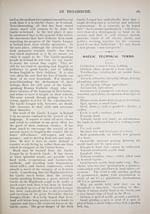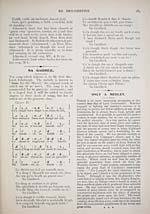Blair Collection > Deo-gréine
(206)
Download files
Complete book:
Individual page:
Thumbnail gallery: Grid view | List view

tSi
AN DEO-GHREINE.
Pliad, pliadan, a plot of ground.
nn-ràcain, a small portion of land, lit.
a rake-head.
fCeapach, a tillage plot, common in names
of pla<
- isreinn, a carucate, plough-land, as much
land as can be tilled with one plough in the
year.
Dabhach, a measure of land of variable
extent according to locality. It may extend
to four carucates or to one only, and may
support 60 cows only, or in the Hebrides 320.
According to Mr. \V. J. Watson's Place Names
■ I Ri iss-shire (p.lxxxi 1 Lewis was divided into
fifteen davochs. Borrowed into Scottish as
daugh, davoch, etc., it is defined as an extent
of land sufficient to produce forty-eight bolls,
and when divided has given place names like
Haddach, Haddo, i.e. half-davoch.
Leth-dabhach, half-davoch, in place names
Lettoch.
Ceathramh, a quarter or fourth part of any-
thing: in denominations of land the fourth of
a davoch usually ; in place names Kerrow, etc.
( >chdamh, an eighth ; in place names Octo,
Octow. '
Coige, a fifth, appears in the names of five
places in Strathdearn.
Fiscal Denominations.
Cionag,cianog,oneeighthofa farthing-land.
L'leitinn, cleitig, clitinn, etc., half of a
fartlnng-land ; one cow's grass ; a croft.
Feoirlinn, feòirlig, a farthing-land; fourth
part of any farm. MacAlpine says a mite,
twelfth part of a penny for which he gives as
another name'turn-odhar'('turn' inEng. = Gael.
part), Scot, turner, a bodle, Fr. turnois.
Leth-pheighinn, a half-penny land.
Peighinn, a penny-land. Multiples occur
e.g. \a Coig Peighinnean, the Five Pennies, a
holding in Eigg now absorbed in another farm.
MacAlpine says peighinn is equal to a groat-
land— cota-ban in Mull. The word appears
to mean a share (of land) in sonic of the islands
and consequently to vary in such cases < I
ing to the value of the particular shares.
Duipeighinn two-penny land, occurs once
or twice. Dippin in Arran, in 1 p5 Dupenny-
Landis, is in Gaelic An Duipeighinn('Duipeinn').
C'< ita-bàn ■ nny-land, groat-land ;
"lei rtl i' .1 , 1 1 1 - .1 1 hem : ochdamh, lour ; ceith-
reamh, eight," says MacAlpine, but he explains
ochdamh as " eight groats land." The unit
here should he i he mark and in that ease the
ceithreamh (fourl h | and the 0( hdamh (eighth |
would be respectively ten groats and five groats.
Sgillinn, a shilling land. The word meant
a shilling in Scots money when this system of
denominating land was instituted, but when
English money came into use, it was found
that the English penny was of the same value
as the Scottish shilling and so sgillinn came
to mean in modern Gaelic a penny sterling.
So bonn-a-sè which meant a sixpence now
means a halfpenny, and a shilling sterling is
i iften called sgillinn Shasunnach or an English
shilling (penny.) In denominations of land
sgillinn retains its old meaning. For example
the forty-shilling land at Acharn Kenmore,
mentioned in Mr. J. Christie's "Lairds and
Lands of Loch Tayside," is in Gaelic, An dà
fhichead sgillinn."
I'nga, an ounce-land, twenty-penny land,
or one eighth of a mark-land.
Marg, a markland, thirteen shillings and
four pence.
The extent of those respective denomina-
tions of land no doubt varied greatly. Pennant
in his description of the island of Canna says:
" Penny lands are named from some old valua-
tion. The sum necessary to stock one is £30.
It maintains seven cows and two horses. The
tenant can raise on it eight bolls of small
black oats, the produce of two ; four bolls of
bear from half a boll, and seven bolls of
potatoes from one." Tour, vol. I. p. 3x5. The
markland should be. 160 times the size of the
pennyland, but the known marklands are
nothing like so many times the size of
Pennant's pennyland. Can it be that the
converse of what took place in the case of the
word sgillinn, has happened to the word
peighinn and that the latter means in land
denominations not the Scots but the English
penny which in value means a Scots shilling?
Probably there is evidence, not available here,
to decide the question. In any case the pro-
portion of a markland to a peighinn-\a.nù is
more like that of a mark to a shilling than
that of a mark to a penny.
According to Skene [Celtic Scotland) the
davoch was divided into four ploughgates to
the east of the central watershed of the
country, and into twenty pennylands to the
west where the davoch was called also a tirung
< ir oumeland. In place-names the davoch which
according to Mr. Watson was "The old stan-
dard measure of land in Pictland," is much in
evidence about the Moray Firth — Sutherland,
Ross, Inverness and on to Aberdeen, — and the
peighinn or pennyland in Argyll and the
Hebrides including Buteand Arran. In Perth-
shire and some other districts the marg or
markland predominates ; there are sixteen
place-names containing the word on the sides
of Loch 'fay.
Fields.
Achadh, a field, meadow, plain ; raon, idem.
Cliatan, cliathdan, a level plot of ground,
'harrowed place' from cliath, harrow; cliata,
a meadow, (M,.\.)
Geadhail, a ploughed field, a park.
AN DEO-GHREINE.
Pliad, pliadan, a plot of ground.
nn-ràcain, a small portion of land, lit.
a rake-head.
fCeapach, a tillage plot, common in names
of pla<
- isreinn, a carucate, plough-land, as much
land as can be tilled with one plough in the
year.
Dabhach, a measure of land of variable
extent according to locality. It may extend
to four carucates or to one only, and may
support 60 cows only, or in the Hebrides 320.
According to Mr. \V. J. Watson's Place Names
■ I Ri iss-shire (p.lxxxi 1 Lewis was divided into
fifteen davochs. Borrowed into Scottish as
daugh, davoch, etc., it is defined as an extent
of land sufficient to produce forty-eight bolls,
and when divided has given place names like
Haddach, Haddo, i.e. half-davoch.
Leth-dabhach, half-davoch, in place names
Lettoch.
Ceathramh, a quarter or fourth part of any-
thing: in denominations of land the fourth of
a davoch usually ; in place names Kerrow, etc.
( >chdamh, an eighth ; in place names Octo,
Octow. '
Coige, a fifth, appears in the names of five
places in Strathdearn.
Fiscal Denominations.
Cionag,cianog,oneeighthofa farthing-land.
L'leitinn, cleitig, clitinn, etc., half of a
fartlnng-land ; one cow's grass ; a croft.
Feoirlinn, feòirlig, a farthing-land; fourth
part of any farm. MacAlpine says a mite,
twelfth part of a penny for which he gives as
another name'turn-odhar'('turn' inEng. = Gael.
part), Scot, turner, a bodle, Fr. turnois.
Leth-pheighinn, a half-penny land.
Peighinn, a penny-land. Multiples occur
e.g. \a Coig Peighinnean, the Five Pennies, a
holding in Eigg now absorbed in another farm.
MacAlpine says peighinn is equal to a groat-
land— cota-ban in Mull. The word appears
to mean a share (of land) in sonic of the islands
and consequently to vary in such cases < I
ing to the value of the particular shares.
Duipeighinn two-penny land, occurs once
or twice. Dippin in Arran, in 1 p5 Dupenny-
Landis, is in Gaelic An Duipeighinn('Duipeinn').
C'< ita-bàn ■ nny-land, groat-land ;
"lei rtl i' .1 , 1 1 1 - .1 1 hem : ochdamh, lour ; ceith-
reamh, eight," says MacAlpine, but he explains
ochdamh as " eight groats land." The unit
here should he i he mark and in that ease the
ceithreamh (fourl h | and the 0( hdamh (eighth |
would be respectively ten groats and five groats.
Sgillinn, a shilling land. The word meant
a shilling in Scots money when this system of
denominating land was instituted, but when
English money came into use, it was found
that the English penny was of the same value
as the Scottish shilling and so sgillinn came
to mean in modern Gaelic a penny sterling.
So bonn-a-sè which meant a sixpence now
means a halfpenny, and a shilling sterling is
i iften called sgillinn Shasunnach or an English
shilling (penny.) In denominations of land
sgillinn retains its old meaning. For example
the forty-shilling land at Acharn Kenmore,
mentioned in Mr. J. Christie's "Lairds and
Lands of Loch Tayside," is in Gaelic, An dà
fhichead sgillinn."
I'nga, an ounce-land, twenty-penny land,
or one eighth of a mark-land.
Marg, a markland, thirteen shillings and
four pence.
The extent of those respective denomina-
tions of land no doubt varied greatly. Pennant
in his description of the island of Canna says:
" Penny lands are named from some old valua-
tion. The sum necessary to stock one is £30.
It maintains seven cows and two horses. The
tenant can raise on it eight bolls of small
black oats, the produce of two ; four bolls of
bear from half a boll, and seven bolls of
potatoes from one." Tour, vol. I. p. 3x5. The
markland should be. 160 times the size of the
pennyland, but the known marklands are
nothing like so many times the size of
Pennant's pennyland. Can it be that the
converse of what took place in the case of the
word sgillinn, has happened to the word
peighinn and that the latter means in land
denominations not the Scots but the English
penny which in value means a Scots shilling?
Probably there is evidence, not available here,
to decide the question. In any case the pro-
portion of a markland to a peighinn-\a.nù is
more like that of a mark to a shilling than
that of a mark to a penny.
According to Skene [Celtic Scotland) the
davoch was divided into four ploughgates to
the east of the central watershed of the
country, and into twenty pennylands to the
west where the davoch was called also a tirung
< ir oumeland. In place-names the davoch which
according to Mr. Watson was "The old stan-
dard measure of land in Pictland," is much in
evidence about the Moray Firth — Sutherland,
Ross, Inverness and on to Aberdeen, — and the
peighinn or pennyland in Argyll and the
Hebrides including Buteand Arran. In Perth-
shire and some other districts the marg or
markland predominates ; there are sixteen
place-names containing the word on the sides
of Loch 'fay.
Fields.
Achadh, a field, meadow, plain ; raon, idem.
Cliatan, cliathdan, a level plot of ground,
'harrowed place' from cliath, harrow; cliata,
a meadow, (M,.\.)
Geadhail, a ploughed field, a park.
Set display mode to: Large image | Transcription
Images and transcriptions on this page, including medium image downloads, may be used under the Creative Commons Attribution 4.0 International Licence unless otherwise stated. ![]()
| Early Gaelic Book Collections > Blair Collection > Deo-gréine > (206) |
|---|
| Permanent URL | https://digital.nls.uk/76699959 |
|---|
| Description | A selection of books from a collection of more than 500 titles, mostly on religious and literary topics. Also includes some material dealing with other Celtic languages and societies. Collection created towards the end of the 19th century by Lady Evelyn Stewart Murray. |
|---|
| Description | Selected items from five 'Special and Named Printed Collections'. Includes books in Gaelic and other Celtic languages, works about the Gaels, their languages, literature, culture and history. |
|---|

